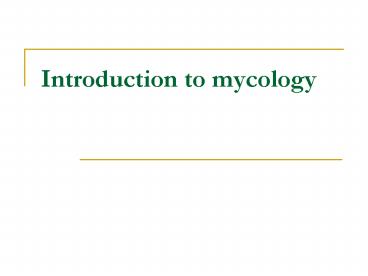Introduction to mycology - PowerPoint PPT Presentation
1 / 16
Title:
Introduction to mycology
Description:
Introduction to mycology Fungi-Eucaryotes Eucaryotic cells with characteristic organelles Thick cell wall, mostly carbohydrate Cellulose or chitin most common ... – PowerPoint PPT presentation
Number of Views:416
Avg rating:3.0/5.0
Title: Introduction to mycology
1
Introduction to mycology
2
Fungi-Eucaryotes
- Eucaryotic cells with characteristic organelles
- Thick cell wall, mostly carbohydrate
- Cellulose or chitin most common components
- No chloroplasts
- Metabolically very similar, distinguished by
morphology - 3 main types
- Yeasts
- Filamentous fungi
- Dimorphic fungi
3
Fungi
- Yeasts
- Dimorphic fungi
- Mycelial fungi
4
Yeasts
- Unicellular fungi
- Grow by division
- Budding
- Binary fission
- Sometimes daughter cells may not detach
themselves the result is a pseudohyphae
Pseudohyphae
5
Filamentous fungi (molds)
- Multicellular, multinucleate
- Basic unit is the hyphae, a long thin filament
- Hyphae branch and cross link to form a mat
(mycelium) - Growth occurs at hyphal tip
- Hyphae may be divided by cross-walls (septa) into
uninuclear units - Septa contain pore. All cytoplasm is connected.
- Non septate hyphae coenocytic
6
Mucor
7
Dimorphic fungi
- Fungi able to switch between growth as a mycelium
and a yeast - Depends on environmental conditions
- Usually one form is pathogenic and the other is
saprophytic - Most cases yeast form is pathogenic, eg,
Histoplasma capsulatum - In some cases hyphal form is pathogenic, eg,
Candida albicans
Histoplasma
Candida albicans
8
Fungal spores Vegetative spores
- Arthrospores, eg, Coccidiodes immitis
- formed by the disarticulation of the mycelium
- Chlamydospores, eg, Candida albicans
- thick-walled, resistant spores formed by the
direct differentiation of hyphae - Blastospores, eg, Candida albicans
- formed by budding from the ends or sides of the
parent cell
9
(No Transcript)
10
Fungal spores Asexual spores
- Some hyphae grow up from the mycelium and
differentiate to produce spores - The most important of these are conidiospores
- The hyphae develops to produce a specialised
spore producing body called the conidiophore - Some fungi produce large conidia containing
multinucleate spores (macroconidia) and small
conidia which produce unicellular spores
(microconidia)
11
Conidiospores
12
Sexual Spores
- Zygospores When two hyphae of suitable mating
strains come into contact each produces a short
side branch, the distal part of which becomes
filled with dense protoplasm and is cut off by a
transverse wall to form the gametangium. - Oospores are characteristic of the more primitive
Phycomycetes. The male gamete reaches the
oosphere (egg) through a germ tube. - Ascospore produced in a sac-like structure
called an ascus
13
Pathogenic mechanisms - Fungi
- Invasiveness multiply in skin and keratin
producing common superficial infection (Ringworm,
athletes foot) - Fungi gaining access to tissue cause subcutaneous
infections - In the blood they cause life threatening systemic
infections in the immunocompromised - Toxin production ingestion of mouldy food in
which fungal metabolites have been produced
causes poisoning - Allergic reactions inhalation of fungal hyphae
or spores causes hypersensitivity reactions
14
Cultivation of fungi
- Fungi are chemoheterotrophs
- Growth requirements similar to bacteria some
require complex substances such as keratin - Optimum growth temperature for many fungi much
lower than for pathogenic bacteria - Most fungi grow at lower pH than bacteria
- Media
- Sabourauds agar
- Dextrose and peptone, pH5.6
- Yeast grow as colonies
- Filamentous fungi grow as a mycelium
15
Terminology
- Ascospore produced in a sac-like structure
called an ascus - Arthospores formed by the disarticulation of the
mycelium - Blastospores are formed by budding from the ends
or sides of the parent cell, e.g., the yeast,
Candida - Chlamydospores thick-walled, resistant spores
formed by the direct differentiation of hyphae - Conidia asexual spore formed from hyphae by
budding or septal division
16
Terminology
- Conidiophore a stalk-like branch from the
mycelium in which conidia develop either singly
or in numbers - Germ tubes tube-like structures produced by
germinating spores - Hyphae the filaments that composed the body of a
fungus - Macroconidia large multinucleate spores
- Microconidia single-celled spores
- Mycelium a mat made up of interwining
thread-like hyphae - Pseudohyphae filaments composed of elongated
budding cells that have failed to detach

